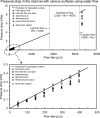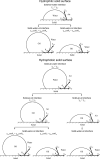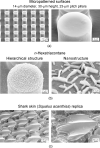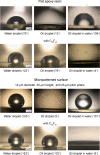Biomimetics inspired surfaces for drag reduction and oleophobicity/philicity
- PMID: 21977417
- PMCID: PMC3148050
- DOI: 10.3762/bjnano.2.9
Biomimetics inspired surfaces for drag reduction and oleophobicity/philicity
Abstract
The emerging field of biomimetics allows one to mimic biology or nature to develop nanomaterials, nanodevices, and processes which provide desirable properties. Hierarchical structures with dimensions of features ranging from the macroscale to the nanoscale are extremely common in nature and possess properties of interest. There are a large number of objects including bacteria, plants, land and aquatic animals, and seashells with properties of commercial interest. Certain plant leaves, such as lotus (Nelumbo nucifera) leaves, are known to be superhydrophobic and self-cleaning due to the hierarchical surface roughness and presence of a wax layer. In addition to a self-cleaning effect, these surfaces with a high contact angle and low contact angle hysteresis also exhibit low adhesion and drag reduction for fluid flow. An aquatic animal, such as a shark, is another model from nature for the reduction of drag in fluid flow. The artificial surfaces inspired from the shark skin and lotus leaf have been created, and in this article the influence of structure on drag reduction efficiency is reviewed. Biomimetic-inspired oleophobic surfaces can be used to prevent contamination of the underwater parts of ships by biological and organic contaminants, including oil. The article also reviews the wetting behavior of oil droplets on various superoleophobic surfaces created in the lab.
Keywords: aquatic animals; biomimetics; drag; lotus plants; shark skin; superhydrophobicity; superoleophobicity.
Figures


















Similar articles
-
Wetting behavior of water and oil droplets in three-phase interfaces for hydrophobicity/philicity and oleophobicity/philicity.Langmuir. 2009 Dec 15;25(24):14165-73. doi: 10.1021/la901906h. Langmuir. 2009. PMID: 19637877
-
Biomimetics: lessons from nature--an overview.Philos Trans A Math Phys Eng Sci. 2009 Apr 28;367(1893):1445-86. doi: 10.1098/rsta.2009.0011. Philos Trans A Math Phys Eng Sci. 2009. PMID: 19324719 Review.
-
Self-cleaning efficiency of artificial superhydrophobic surfaces.Langmuir. 2009 Mar 3;25(5):3240-8. doi: 10.1021/la803860d. Langmuir. 2009. PMID: 19239196
-
Lessons from nature for green science and technology: an overview and bioinspired superliquiphobic/philic surfaces.Philos Trans A Math Phys Eng Sci. 2019 Feb 11;377(2138):20180274. doi: 10.1098/rsta.2018.0274. Philos Trans A Math Phys Eng Sci. 2019. PMID: 30967074 Review.
-
Constructing a Dual-Function Surface by Microcasting and Nanospraying for Efficient Drag Reduction and Potential Antifouling Capabilities.Micromachines (Basel). 2019 Jul 23;10(7):490. doi: 10.3390/mi10070490. Micromachines (Basel). 2019. PMID: 31340477 Free PMC article.
Cited by
-
Physics, chemistry and biology of functional nanostructures.Beilstein J Nanotechnol. 2012;3:843-5. doi: 10.3762/bjnano.3.94. Epub 2012 Dec 11. Beilstein J Nanotechnol. 2012. PMID: 23365797 Free PMC article. No abstract available.
-
Collembola cuticles and the three-phase line tension.Beilstein J Nanotechnol. 2017 Aug 18;8:1714-1722. doi: 10.3762/bjnano.8.172. eCollection 2017. Beilstein J Nanotechnol. 2017. PMID: 28875109 Free PMC article.
-
Natural insect and plant micro-/nanostructsured surfaces: an excellent selection of valuable templates with superhydrophobic and self-cleaning properties.Molecules. 2014 Sep 2;19(9):13614-30. doi: 10.3390/molecules190913614. Molecules. 2014. PMID: 25185068 Free PMC article. Review.
-
Molecular organization of the nanoscale surface structures of the dragonfly Hemianax papuensis wing epicuticle.PLoS One. 2013 Jul 9;8(7):e67893. doi: 10.1371/journal.pone.0067893. Print 2013. PLoS One. 2013. PMID: 23874463 Free PMC article.
-
Survival of polymeric microstructures subjected to interrogatory touch.PLoS One. 2021 Sep 2;16(9):e0255980. doi: 10.1371/journal.pone.0255980. eCollection 2021. PLoS One. 2021. PMID: 34473714 Free PMC article.
References
-
- Gordon J E. The New Science of Strong Materials, or Why You Don’t Fall Through the Floor. 2nd ed. Princeton: Princeton University Press; 1984.
-
- Bhushan B. Springer Handbook of Nanotechnology. 3rd ed. Heidelberg, Germany: Springer; 2010. - DOI
-
- Barthlott W, Neinhuis C. Planta. 1997;202:1–8. doi: 10.1007/s004250050096. - DOI
-
- Neinhuis C, Barthlott W. Ann Bot (Oxford, U K) 1997;79:667–677. doi: 10.1006/anbo.1997.0400. - DOI
Grants and funding
LinkOut - more resources
Full Text Sources
Other Literature Sources
Miscellaneous
